Thermo Fisher Scientific Template Generation System II kit User guide
- Type
- User guide

Thermo Scientific
Template Generation System II Kit
Technical Manual
F-702 20 reactions


3
Table of contents
1. Strategy outline ................................................................................................ 4
2. Kit components ................................................................................................ 5
3. User-supplied materials ................................................................................... 6
4. Transposition reaction protocol ....................................................................... 7
5. Transformation ................................................................................................. 8
6. Insertion mapping by colony-PCR .................................................................... 9
6.1 DNA amplification ..................................................................................... 9
6.2 Agarose gel electrophoresis ................................................................... 10
7. DNA sequencing ............................................................................................ 11
7.1 Sequencing from PCR products ............................................................. 11
7.2 Sequencing from plasmid DNA .............................................................. 11
Appendix I: Descriptions of kit components ........................................................ 12
Appendix II: Maps and sequences of entranceposons ........................................ 14
Appendix III: Media recipes ................................................................................. 17
Appendix IV: Related products ............................................................................ 18
Appendix V: Mu transposition references ............................................................ 19
Product use limitation .......................................................................................... 19

4
1. Strategy outline
1. Purify your target DNA, i.e., the plasmid, cosmid, BAC or PAC clone that you wish to
sequence. Note: The Thermo Scientific Template Generation System II Kit can also be
used to insert Entranceposons into linear target DNA (e.g., a restriction fragment or a
PCR product). A slightly modified reaction protocol is available at
www.thermoscientific.com/tgs.
2. Choose one of the three Entranceposons included in the kit.
3. Perform the transposition reaction.
4. Transform competent E. coli cells with the transposition reaction mixture using either
a chemical transformation method or electroporation.
5. Grow transformants on selection plates.
6. Pick clones for DNA sequencing. Choose either a “shotgun” approach, i.e., the
clones are not analyzed before sequencing reactions or a “directed” approach, i.e.,
Entranceposon insertion sites in the clones are mapped by performing colony-PCR
reactions. Note: The PCR products from the mapping reactions can also be used
directly as templates for DNA sequencing reactions.
7. Prepare plasmid DNA from the clones that you plan to sequence.
8. Use primers SeqE and SeqW for bidirectional DNA sequencing in a single reaction or
in two separate reactions, depending on the DNA sequencing chemistry at hand.

5
2. Kit components
The kit contains sufficient materials for 20 reactions. See Appendix I for more detailed
information.
Product # Product Size
Artificial transposons:
F-778 Entranceposon* (CamR-3) 20 µl
F-779 Entranceposon* (KanR-3) 20 µl
F-784 Entranceposon* (TetR-3) 20 µl
F-750 MuA Transposase 20 µl
F-752 5X Reaction Buffer for MuA Transposase 100 µl
F-753 Control Target DNA 10 µl
Primers for insertion mapping:
F-754 pUC Fwd Primer 400 µl
F-755 pUC Rev Primer 400 µl
F-756 MuEnd Primer 800 µl
Primers for DNA sequencing:
F-780 SeqE Primer 250 µl
F-781 SeqW Primer 250 µl
* See Appendix II for the complete sequences of the Entranceposons.
Store the components at -20°C.
Material safety data sheet (MSDS) is available at www.thermoscientific.com/fzmsds.

6
3. User-supplied materials
Target DNA
Use 60 fmoles of target DNA per a 20 µl reaction. The amount equals approximately
40 ng DNA per kb of target.
Example: Your target DNA plasmid consists of a 6 kb insert cloned into a 2.8 kb vector.
The size of the target plasmid is 6 kb + 2.8 kb = 8.8 kb. The optimal amount of target DNA
per reaction is: 8.8 kb × 40 ng/kb = 352 ng. Therefore, you should use 300-400 ng of the
target plasmid per reaction.
For large DNA constructs (cosmids, BACs or PACs) use maximum of 2 µg target DNA per
reaction.
Important: Make sure that your target DNA replicon does not contain the same selection
marker as the Entranceposon that you plan to use (CamR,KanR or TetR).
Purify target DNA using standard methods such as alkaline lysis or commercial DNA
purification kits. Target DNA should be in a low-salt buffer such as 1X TE buffer or in
deionized water.
Competent cells
Any standard E. coli strain that is suitable for DNA cloning can be used as a transformation
host.
Important: Make sure that the E. coli strain is not resistant to the antibiotic that you plan
to use for selecting the insertion clones after transformation (chloramphenicol, kanamycin
or tetracycline).
Both electrocompetent and chemically competent E. coli cells may be used. Electroporation
is the recommended transformation method for large target DNA molecules (>20 kb).
Thermal Cycler: Thermal cycler or heat blocks, 30°C and 75°C
Reagents: Reagents and equipment for PCR mapping
Media: SOC medium and LB agar plates with antibiotics
See Appendix III for the media recipes.

7
4. Transposition reaction protocol
1. Set up the following reaction:
Important: MuA Transposase should be added last.
Reagent Volume
Target DNA (see “User-Supplied Materials”) 1 to 14 µl
H2O add to 20 µl
5X Reaction Buffer for MuA Transposase 4 µl
Entranceposon (CamR-3) OR (KanR-3) OR (TetR-3) 1 µl
MuA Transposase 1 µl
20 µl
For the control reaction, use 1 µl (370 ng) of Control Target DNA supplied with the kit.
2. Mix the reagents. Do not vortex.
3. Incubate 1 hour at 30°C.
4. Heat inactivate at 75°C for 10 minutes.
5. Transform.

8
5. Transformation
Chemical transformation
Transform 1-10 µl of the reaction mixture per 50-100 µl competent E. coli cells. Follow
standard transformation protocols or proceed as instructed by the manufacturer of your
competent cells.
Electroporation
Dilute the reaction mixture 10-fold in deionized water. Use 1-10 µl of the dilution per one
electroporation shot (typically 40-50 µl of electrocompetent E. coli cells).
Before plating on selective plates, it is necessary to grow the cells in 1 ml SOC medium
for one hour at 37°C to ensure marker gene expression from the inserted Entranceposon.
Plate 5, 50 and 500 µl of the transformation mixture (1 ml) on selection plates:
LB+ chloramphenicol (20 µg/ml)
OR
LB+ kanamycin (20 µg/ml)
OR
LB+ tetracycline (10 µg/ml)
Note: To reduce the number of insertions in the vector backbone, supplement the selection
plates with the antibiotic that selects your target plasmid.
Incubate the plates overnight at 37°C.

9
6. Insertion mapping by colony-PCR
When the target plasmid is relatively small (<10 kb) it is feasible to apply the “directed”
approach, i.e., to map the Entranceposon insertion sites first by colony-PCR and then, based
on the mapping data, to choose a minimal set of overlapping templates for DNA sequencing.
6.1 DNA amplification
Perform two separate 20-µl PCR reactions per an insertion clone to ensure reliable mapping
of Entranceposon insertion sites.
1. Prepare two PCR reaction master mixes, one with the primers MuEnd and pUC Fwd
and the other with MuEnd and pUC Rev.
Reagent Final conc. Volume
H2O 14.4 µl
5X Phire Reaction Buffer 1 × 4 µl
dNTPs (10 mM each) 200 µM each 0.4 µl
pUC Fwd OR pUC Rev Primer (25 µM) 0.5 µM 0.4 µl
Mu End Primer (25 µM) 0.5 µM 0.4 µl
Phire Hot Start II DNA Polymerase 0.4 µl
20 µl
Note: The reaction conditions above have been optimized for Thermo Scientific Phire Hot
Start II DNA Polymerase. Efficient amplification of most GC-rich sequences can be achieved
by supplementing the reaction mixture with 5% DMSO and by decreasing the annealing
temperature 2-3°C.
2. Aliquot 19 µl of the PCR reaction master mixes into reaction tubes on ice.
3. Touch a colony on a selection plate with a pipet tip. Dip the pipet tip into 50 µl deionized
water to suspend the cells.
4. Pipet 1 µl of the cell suspension into two separate reaction tubes. Also transfer a small
amount of the dilution on an appropriate selection plate to “replica-plate” the colonies
picked for the PCR mapping reactions.

10
5. Use the following thermal cycling protocol for DNA amplification:
Step Temperature Time
Step 1 98°C 30 s
Step 2 98°C 5 s
Step 3 72°C 10-15 s/kb
Repeat the steps 2-3 30 times
Note: If using primers not provided in the kit, please refer to Phire Hot Start II DNA Polymerase instruction manual for
information on annealing determination and Tm calculation for primers.
6.2 Agarose gel electrophoresis
Analyze the PCR products by standard agarose gel electrophoresis. The lengths of the
PCR products obtained from a given clone with the primer pairs MuEnd+pUC Fwd and
MuEnd+pUC Rev equal to the distance between the Entranceposon insertion site and the
pUC Fwd and pUC Rev primer, respectively. If the Entranceposon insertion in a given clone
lies in the insert DNA (in the sequence between the primers pUC Fwd and pUC Rev) the
sizes of the two PCR products from that clone should add up to the size of the insert DNA
fragment. If the additive size of the two PCR products for a clone is bigger than the size
of the insert DNA fragment, the Entranceposon insertion has most likely occurred in the
vector backbone of the target plasmid.
Note: The Entranceposon insertion sites in target DNA can also be mapped using
restriction enzymes. There are several unique restriction enzyme sites for that purpose in
each Entranceposon (see Appendix II).

11
7. DNA sequencing
7.1 Sequencing from PCR products
Select clones for DNA sequencing using the information
obtained from the colony PCR mapping reactions. Purify
PCR-amplified DNA using standard techniques such as gel
filtration if that is required.
Important: Use the primer MuEnd for sequencing directly
from PCR-amplified DNA. A linear PCR product amplified
with MuEnd and a vector primer does not contain binding
sites for the DNA sequencing primers SeqE and SeqW.
The recommended annealing temperature in a cycle
sequencing reaction for the primer MuEnd is 60°C.
7.2 Sequencing from plasmid DNA
Prepare plasmid DNA from insertion clones using standard
techniques.
Important: Use the primers SeqW or SeqE for sequencing
from plasmid DNA. The primer MuEnd anneals on the
terminal repeat sequences present at each end of the
Entranceposon.
The recommended annealing temperature in a cycle
sequencing reaction for the primers SeqW and SeqE is 50°C.
Important: The transposition reaction generates a 5 bp
sequence duplication at the Entranceposon insertion site.

12
Appendix I: Descriptions of kit components
F-778 Entranceposon (CamR-3)
20 µl 20 ng/µl in TE, pH 8.0
F-779 Entranceposon (KanR-3)
20 µl 20 ng/µl in TE, pH 8.0
F-784 Entranceposon (TetR-3)
20 µl 25 ng/µl in TE, pH 8.0
Entranceposons are composed of inverted repeats of the bacteriophage Mu right end
sequences flanking a selectable marker gene. The marker genes cat, npt and tet confer
resistance to chloramphenicol, kanamycin and tetracycline, respectively.
F-750 MuA Transposase
20 µl 0.22 µg/µl in MuA Storage Buffer
A single purified polypeptide that catalyzes the chemical reactions of transposition. Isolated
from an E. coli strain carrying the MuA gene.
F-752 5X Reaction Buffer for MuA Transposase
100 µl 5X conc.
F-753 Control Target DNA
10 µl 370 ng/µl in TE, pH 8.0
A 6.6 kb HindIII fragment of bacteriophage lambda DNA cloned into the HindIII site of pUC19.

13
Primers for insertion mapping
F-754 pUC Fwd Primer
400 µl 25 µM in H2O
5’-AGCTGGCGAAAGGGGGATGTG-3’
Tm 73.5°C (0.5 µM)*
Binding site in pUC19 between the basepairs 307 and 327.
F-755 pUC Rev Primer
400 µl 25 µM in H2O
5’-TTATGCTTCCGGCTCGTATGTTGTGT-3’
Tm 71.6°C (0.5 µM)
Binding site in pUC19 between the basepairs 535 and 510.
Note: The majority of commonly used cloning vectors are pUC-derivatives and most of
them have preserved the binding sites for pUC Fwd and pUC Rev.
F-756 MuEnd Primer
800 µl 25 µM in H2O
5’-GTTTTTCGTGCGCCGCTTCA-3’
Tm 72.5°C (0.5 µM)
Important: The binding site of the MuEnd primer is present at each end of Entranceposon.
Therefore, MuEnd cannot be used for sequencing from a plasmid clone that contains an
intact copy of Entranceposon.
Primers for DNA sequencing
F-780 SeqE Primer
250 µl 10 µM in H2O
5’-CGACACACTCCAATCTTTCC-3’
Tm 59.1°C (0.1 µM)
F-781 SeqW Primer
250 µl 10 µM in H2O
5’-GGTGGCTGGAGTTAGACATC-3’
Tm 58.1°C (0.1 µM)
* Tm calculations were done with Thermo Scientific Tm calculator available in www.thermoscientific.com/pcrwebtools).

14
Appendix II: Maps and sequences of entranceposons
Entranceposon (CamR-3), 1302 bp:
cat (Cam )
R
SeqW
SeqE
MuEnd
MuEnd
1 TGAAGCGGCGCACGAAAAACGCGAAAGCGTTTCACGATAAATGCGAAAACGATGTCTAACTCCAGCCACCGTTTAAACGGATCCTTTTCGACCGAATAAA
101 TACCTGTGACGGAAGATCACTTCGCAGAATAAATAAATCCTGGTGTCCCTGTTGATACCGGGAAGCCCTGGGCCAACTTTTGGCGAAAATGAGACGTTGA
201 TCGGCACGTAAGAGGTTCCAACTTTCACCATAATGAAATAAGATCACTACCGGGCGTATTTTTTGAGTTGTCGAGATTTTCAGGAGCTAAGGAAGCTAAA
301 ATGGAGAAAAAAATCACTGGATATACCACCGTTGATATATCCCAATGGCATCGTAAAGAACATTTTGAGGCATTTCAGTCAGTTGCTCAATGTACCTATA
401 ACCAGACCGTTCAGCTGGATATTACGGCCTTTTTAAAGACCGTAAAGAAAAATAAGCACAAGTTTTATCCGGCCTTTATTCACATTCTTGCCCGCCTGAT
501 GAATGCTCATCCGGAATTACGTATGGCAATGAAAGACGGTGAGCTGGTGATATGGGATAGTGTTCACCCTTGTTACACCGTTTTCCATGAGCAAACTGAA
601 ACGTTTTCATCGCTCTGGAGTGAATACCACGACGATTTCCGGCAGTTTCTACACATATATTCGCAAGATGTGGCGTGTTACGGTGAAAACCTGGCCTATT
701 TCCCTAAAGGGTTTATTGAGAATATGTTTTTCGTCTCAGCCAATCCCTGGGTGAGTTTCACCAGTTTTGATTTAAACGTGGCCAATATGGACAACTTCTT
801 CGCCCCCGTTTTCACCATGGGCAAATATTATACGCAAGGCGACAAGGTGCTGATGCCGCTGGCGATTCAGGTTCATCATGCCGTTTGTGATGGCTTCCAT
901 GTCGGCAGAATGCTTAATGAATTACAACAGTACTGCGATGAGTGGCAGGGCGGGGCGTAATTTTTTTAAGGCAGTTATTGGTGCCCTTAAACGCCTGGTT
1001 GCTACGCCTGAATAAGTGATAATAAGCGGATGAATGGCAGAAATTCGAAAGCAAATTCGACCCGGTCGTCGGTTCAGGGCAGGGTCGTTAAATAGCCGCT
1101 TATGTCTATTGCTGGTTTACCGGTTTATTGACTACCGGAAGCAGTGTGACCGTGTGCTTCTCAAATGCCTGAGGCCAGTTTGCTCAGGCTCTCCCCGTGG
1201 AGGTAATAATTGACGATAGGATCCGCGGCCGCCGACACACTCCAATCTTTCCGTTTTCGCATTTATCGTGAAACGCTTTCGCGTTTTTCGTGCGCCGCTT
1301 CA
PmeIBamHI
BamHI NotI
ScaI
SspINcoI
PvuI

15
Entranceposon (KanR-3), 1195 bp:
npt (Kan )
R
SeqW
SeqE
MuEnd
MuEnd
1 TGAAGCGGCGCACGAAAAACGCGAAAGCGTTTCACGATAAATGCGAAAACGATGTCTAACTCCAGCCACCGTTTAAACGGATCCTAGTAAGCCACGTTGT
101 GTCTCAAAATCTCTGATGTTACATTGCACAAGATAAAAATATATCATCATGAACAATAAAACTGTCTGCTTACATAAACAGTAATACAAGGGGTGTTATG
201 AGCCATATTCAACGGGAAACGTCTTGCTCGAGGCCGCGATTAAATTCCAACATGGATGCTGATTTATATGGGTATAAATGGGCTCGCGATAATGTCGGGC
301 AATCAGGTGCGACAATCTATCGATTGTATGGGAAGCCCGATGCGCCAGAGTTGTTTCTGAAACATGGCAAAGGTAGCGTTGCCAATGATGTTACAGATGA
401 GATGGTCAGACTAAACTGGCTGACGGAATTTATGCCTCTTCCGACCATCAAGCATTTTATCCGTACTCCTGATGATGCATGGTTACTCACCACTGCGATC
501 CCCGGGAAAACAGCATTCCAGGTATTAGAAGAATATCCTGATTCAGGTGAAAATATTGTTGATGCGCTGGCAGTGTTCCTGCGCCGGTTGCATTCGATTC
601 CTGTTTGTAATTGTCCTTTTAACAGCGATCGCGTATTTCGTCTCGCTCAGGCGCAATCACGAATGAATAACGGTTTGGTTGATGCGAGTGATTTTGATGA
701 CGAGCGTAATGGCTGGCCTGTTGAACAAGTCTGGAAAGAAATGCATAAGCTTTTGCCATTCTCACCGGATTCAGTCGTCACTCATGGTGATTTCTCACTT
801 GATAACCTTATTTTTGACGAGGGGAAATTAATAGGTTGTATTGATGTTGGACGAGTCGGAATCGCAGACCGATACCAGGATCTTGCCATCCTATGGAACT
901 GCCTCGGTGAGTTTTCTCCTTCATTACAGAAACGGCTTTTTCAAAAATATGGTATTGATAATCCTGATATGAATAAATTGCAGTTTCATTTGATGCTCGA
1001 TGAGTTTTTCTAATCAGAATTGGTTAATTGGTTGTAACACTGGCAGAGCATTACGCTGACTTGACGGGACGGCGGCTTTGTTGAATAAATCGAACTTTAT
1101 TCGGTCGAAAAGGATCCGCGGCCGCCGACACACTCCAATCTTTCCGTTTTCGCATTTATCGTGAAACGCTTTCGCGTTTTTCGTGCGCCGCTTCA
PmeI
BamHI NotI
BamHI
XhoI
SspI
HindIII

16
Entranceposon (TetR-3), 1528 bp:
tet (Tet )
R
SeqW
SeqE
MuEnd
MuEnd
1 TGAAGCGGCGCACGAAAAACGCGAAAGCGTTTCACGATAAATGCGAAAACGATGTCTAACTCCAGCCACCGTTTAAACGGATCCTTCTCATGTTTGACAG
101 CTTATCATCGATAAGCTTTAATGCGGTAGTTTATCACAGTTAAATTGCTAACGCAGTCAGGCACCGTGTATGAAATCTAACAATGCGCTCATCGTCATCC
201 TCGGCACCGTCACCCTGGATGCTGTAGGCATAGGCTTGGTTATGCCGGTACTGCCGGGCCTCTTGCGGGATATCGTCCATTCCGACAGCATCGCCAGTCA
301 CTATGGCGTGCTGCTAGCGCTATATGCGTTGATGCAATTTCTATGCGCACCCGTTCTCGGAGCACTGTCCGACCGCTTTGGCCGCCGCCCAGTCCTGCTC
401 GCTTCGCTACTTGGAGCCACTATCGACTACGCGATCATGGCGACCACACCCGTCCTGTGGATCCTCTACGCCGGACGCATCGTGGCCGGCATCACCGGCG
501 CCACAGGTGCGGTTGCTGGCGCCTATATCGCCGACATCACCGATGGGGAAGATCGGGCTCGCCACTTCGGGCTCATGAGCGCTTGTTTCGGCGTGGGTAT
601 GGTGGCAGGCCCCGTGGCCGGGGGACTGTTGGGCGCCATCTCCTTGCATGCACCATTCCTTGCGGCGGCGGTGCTCAACGGCCTCAACCTACTACTGGGC
701 TGCTTCCTAATGCAGGAGTCGCATAAGGGAGAGCGTCGACCGATGCCCTTGAGAGCCTTCAACCCAGTCAGCTCCTTCCGGTGGGCGCGGGGCATGACTA
801 TCGTCGCCGCACTTATGACTGTCTTCTTTATCATGCAACTCGTAGGACAGGTGCCGGCAGCGCTCTGGGTCATTTTCGGCGAGGACCGCTTTCGCTGGAG
901 CGCGACGATGATCGGCCTGTCGCTTGCGGTATTCGGAATCTTGCACGCCCTCGCTCAAGCCTTCGTCACTGGTCCCGCCACCAAACGTTTCGGCGAGAAG
1001 CAGGCCATTATCGCCGGCATGGCGGCCGACGCGCTGGGCTACGTCTTGCTGGCGTTCGCGACGCGAGGCTGGATGGCCTTCCCCATTATGATTCTTCTCG
1101 CTTCCGGCGGCATCGGGATGCCCGCGTTGCAGGCCATGCTGTCCAGGCAGGTAGATGACGACCATCAGGGACAGCTTCAAGGATCGCTCGCGGCTCTTAC
1201 CAGCCTAACTTCGATCATTGGACCGCTGATCGTCACGGCGATTTATGCCGCCTCGGCGAGCACATGGAACGGGTTGGCATGGATTGTAGGCGCCGCCCTA
1301 TACCTTGTCTGCCTCCCCGCGTTGCGTCGCGGTGCATGGAGCCGGGCCACCTCGACCTGAATGGAAGCCGGCGGCACCTCGCTAACGGATTCACCACTCC
1401 AAGAATTGGAGCCAATCAATTCTTGCGGATTATTCGGTCGAAAAGGATCCGCGGCCGCCGACACACTCCAATCTTTCCGTTTTCGCATTTATCGTGAAAC
1501 GCTTTCGCGTTTTTCGTGCGCCGCTTCA
PmeI
BamHI NotI
BamHI
EcoRV
BamHI
NheI
SphI
SalI

17
Appendix III: Media recipes
LB agar with antibiotics, per liter
Tryptone 10 g
Yeast Extract 5 g
NaCl 10 g
Agar 15 g
Adjust pH to 7.0 with 1 M NaOH
Autoclave
Cool to 55°C and add:
Chloramphenicol (per liter) OR 20 mg
Kanamycin (per liter) OR 20 mg
Tetracycline (per liter) 10 mg
Optional: Supplement the medium with the antibiotic that selects for the
target DNA replicon.
SOC medium, per liter
Tryptone 20 g
Yeast Extract 5 g
NaCl 0.5 g
KCl (final 2.5 mM) 0.186 g
Adjust pH to 7.0 with 1 M NaOH
Autoclave
Before use add sterile solutions:
1 M MgCl2 10 ml
1 M MgSO4 10 ml
1 M Glucose 20 ml

18
Appendix IV: Related products
Stand-alone enzymes
F-750 MuA Transposase
F-750C MuA Transposase, 5X conc.
Ready-to-use Entranceposons
F-778 Entranceposon (CamR-3)
F-779 Entranceposon (KanR-3)
F-784 Entranceposon (TetR-3)
F-771 Entranceposon (supF)
F-774 Entranceposon (lacZ)
Plasmid Entranceposons
F-765 pEntranceposon (CamR)
F-766 pEntranceposon (KanR)
F-767 pEntranceposon (TetR)
F-773 pEntranceposon (supF)
F-701 Mutation Generation System MGS
PCR products
F-122S/L Thermo Scientific Phire Hot Start II DNA Polymerase

19
Appendix V: Mu Transposition references
Haapa, S., Suomalainen, S., Eerikäinen, S., Airaksinen, M., Paulin, L., and Savilahti, H.
(1999a). An efficient DNA sequencing strategy based on the bacteriophage Mu in vitro
DNA transposition reaction. Genome Res. 9, 308-315.
Haapa, S., Taira, S., Heikkinen, E., and Savilahti, H. (1999b). An efficient and accurate
integration of mini-Mu transposons in vitro: a general methodology for functional genetic
analysis and molecular biology applications. Nucleic Acids Res. 27, 2777-2784.
Mizuuchi, K. (1992). Transpositional recombination: mechanistic insights from studies of
Mu and other elements. Annu. Rev. Biochem. 61, 1011-1051.
Savilahti, H., Rice, P.A., and Mizuuchi, K. (1995). The phage Mu transpososome core: DNA
requirements for assembly and function. EMBO J. 14, 4893-4903.
Lamberg, A., Nieminen, S., Qiao, M. and Savilahti H. (2002). Efficient insertion mutagenesis
strategy for bacterial genomes involving electroporation of in vitro-assembled DNA
transposition complexes of bacteriophage mu. Appl. Environ. Microbiol. 68, 705-12.
Vilen, H., Eerikäinen, S., Tornberg, J., Airaksinen, M.S., Savilahti, H. (2001). Construction of
gene-targeting vectors: a rapid Mu in vitro DNA transposition-based strategy generating
null, potentially hypomorphic, and conditional alleles. Transgenic Res. 10, 69-80.
Product use limitation
This product has been developed and is sold exclusively for research purposes and in vitro use only. This product has
not been tested for use in diagnostics or drug development, nor is it suitable for administration to humans or animals.
The quality system of Finnzymes Oy, now part of Thermo Fisher Scientific, is certified according to standard SFS-EN
ISO9001:2008.

© 2012 Thermo Fisher Scientific Inc. All rights reserved. All trademarks are the property of
Thermo Fisher Scientific Inc. and its subsidiaries.
v2_2012
Technical support:
US: techservice.genomics@thermofisher.om
Europe, Asia, Rest of World:
techservice.emea.genomics@thermofisher.com
Thermo Scientific Template Generation System II Kit
Technical Manual
-
 1
1
-
 2
2
-
 3
3
-
 4
4
-
 5
5
-
 6
6
-
 7
7
-
 8
8
-
 9
9
-
 10
10
-
 11
11
-
 12
12
-
 13
13
-
 14
14
-
 15
15
-
 16
16
-
 17
17
-
 18
18
-
 19
19
-
 20
20
Thermo Fisher Scientific Template Generation System II kit User guide
- Type
- User guide
Ask a question and I''ll find the answer in the document
Finding information in a document is now easier with AI
Related papers
-
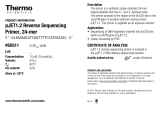 Thermo Fisher Scientific pJET1.2 User guide
Thermo Fisher Scientific pJET1.2 User guide
-
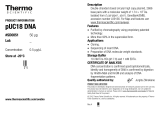 Thermo Fisher Scientific pUC18, pUC19 DNA User guide
Thermo Fisher Scientific pUC18, pUC19 DNA User guide
-
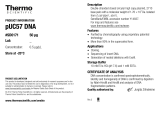 Thermo Fisher Scientific pUC57 DNA User guide
Thermo Fisher Scientific pUC57 DNA User guide
-
 Thermo Fisher Scientific Phire Green Reaction Buffer User guide
Thermo Fisher Scientific Phire Green Reaction Buffer User guide
-
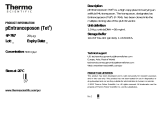 Thermo Fisher Scientific pEntranceposon User guide
Thermo Fisher Scientific pEntranceposon User guide
-
 Thermo Fisher Scientific MuA Transposase, 4.4 ug, 0.22 ug/uL User guide
Thermo Fisher Scientific MuA Transposase, 4.4 ug, 0.22 ug/uL User guide
-
 Thermo Fisher Scientific Phire Green Hot Start II PCR Master Mix User guide
Thermo Fisher Scientific Phire Green Hot Start II PCR Master Mix User guide
-
 Thermo Fisher Scientific pEntranceposon User guide
Thermo Fisher Scientific pEntranceposon User guide
-
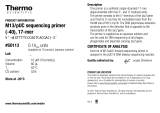 Thermo Fisher Scientific M13/pUC sequencing primer User guide
Thermo Fisher Scientific M13/pUC sequencing primer User guide
-
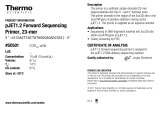 Thermo Fisher Scientific pJET1.2 Forward Sequencing Primer User guide
Thermo Fisher Scientific pJET1.2 Forward Sequencing Primer User guide






























